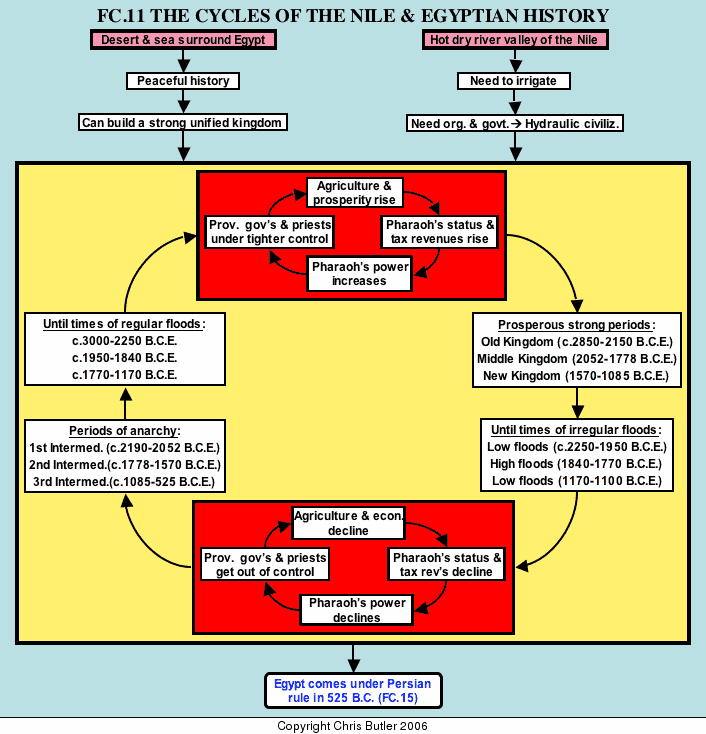FC11The Cycles of the Nile & Egyptian History
Egypt was the scene of the other great hydraulic or river civilization of the ancient Near East. Like its Mesopotamian counterpart, it evolved in a hot dry river valley that required irrigation which in turn required organization and a strong government that led to civilization. In fact, Egyptians depended so much on the irrigation and the high level of organization and authority needed to maintain it that they considered their rulers, the pharaohs, gods. The power and effectiveness of these god-kings corresponded directly to Egypt's prosperity, which itself depended on the floods' regularity and the effectiveness of the irrigation system.
However, Egypt, unlike Mesopotamia, which had no natural barriers and was open to attack, was isolated by desert to the east and west and the Mediterranean Sea to the north. As a result, its history was relatively peaceful compared to Mesopotamia's, allowing the Egyptians to build a strong centralized state without external disruptions. Egypt's more peaceful environment tended to make the Egyptians optimistic about life, but also suspicious of strangers and new ideas.
More than anything else, the Egyptians realized quite well that their prosperity and welfare depended on the Nile which provided its people with most of what they needed to survive: fish and wildlife, mud for building materials, a "highway" for easy transportation, and papyrus for paper. Most importantly, the Nile floods annually from June to October, watering the ground and replenishing the soil with a rich fertile layer of silt. The Egyptians called their land kmt ("the Black land") after this layer of silt. The real essence of Egypt consisted of a long thin strip of land along the Nile that was never more than a few miles wide. Outside of this strip was the "Red land", the desert. Today one can still stand literally with one foot in the "Black land" and one foot in the "Red land". To the ancient Egyptians, this symbolized the sharp contrast between life and death.
The Egyptian peasant's yearly schedule revolved around the Nile's cycle. During the flood season, he might work on the pharaoh's projects, such as pyramids. When the floods subsided, he would repair any damage to his home and the irrigation canals and then plant his crops. Harvest time would come in time to gather the crops right before the Nile flooded, and the cycle would start all over again.
Egyptian history overall followed a basic cycle corresponding to and ruled by the Nile's flood cycles. Regular floods led to prosperous agriculture, which would increase the pharaoh's tax revenues and his status in the eyes of his subjects who saw him as responsible for the floods as well as irrigation. As a result, his power and the ability to control the local governors and priests in the various city-states ( nomes) stretched out along the length of the Nile River valley would grow. Pharaoh's increased authority would bring the irrigation system under even tighter and more efficient control, which would further improve Egypt's agriculture and prosperity. This cycle would keep repeating itself as long as regular floods continued.
However, when irregular floods started, the cycle would reverse itself. The agriculture would decline, lowering the pharaoh's tax revenues and discrediting him in the eyes of his subjects. His power and status would decline, as would his control over the provincial governors and priests. As they got increasingly out of control, the efficiency of the irrigation system would decline, further damaging the agriculture and so on. This cycle would also keep repeating until regular floods would return, and the first part of the cycle would start over.
As a result, Egypt's history is divided into six periods whose prosperous times corresponded roughly to regular floods of the Nile and whose troubled times corresponded to periods when the Nile's annual floods were either too high or too low:
| The Old Kingdom (c.2850-2150 B.C.E.) | Regular floods (c.3000-2250 B.C.E.) |
|---|---|
| The First Intermediate Period (c.2190-2052 B.C.E.) | Low floods (c.2250-1950 B.C.E.) |
| The Middle Kingdom (c.2052-1778 B.C.E.) | Regular floods (c.1950-1840 B.C.E.) |
| The Second Intermediate Period (c.1778-1570 B.C.E.) | High floods (c.1840-1770 B.C.E.) |
| The New Kingdom (c.1570-1085 B.C.E.) | Regular floods (c.1770-1170 B.C.E.) |
| The Final Decline (c.1085-525 B.C.E.) | Low floods (c.1170-1100 B.C.E.) |
